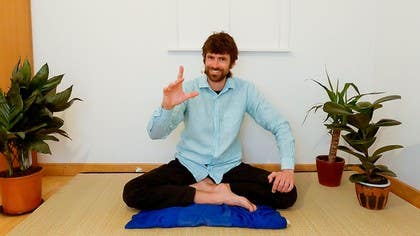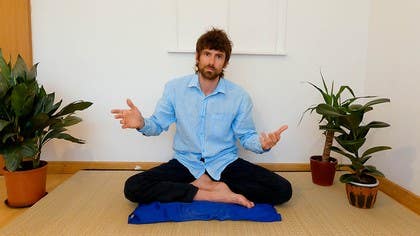Description
About This Video
Transcript
Read Full Transcript
This is the 15th Sutra of Chapter 2. Some people consider this the very center of the sutras. What does this sutra say? So Patanjali has just told us that the type of life, state and experiences that we have will depend on the type of actions that are coming to fruition. So if we have done things that have caused suffering, we can expect that suffering to come back and be visited upon as we have to work through it.
If we have done things that have supported lots of joy and harmony, then we can expect joy and harmony to come towards us. And so one could think, oh, does that mean if I just always make a best effort to experience joy and happiness, then I'll be joyful and happy all the time. And Patanjali says, no human being, because what do we know about life? Life is change. Life is nature.
We are nature. What does nature mean? It means that which is born. So nat from the Latin root. So I think like natal, the salmon returned to their natal streams, the streams where they were born.
So nature is that which is born and everything that is born will die. And in between those two great changes of birth and death, more or less the only thing we can be sure of is constant change. And so Patanjali says, because of this constant change, the wise, those who are discerning, those who have discriminating wisdom, they recognize that Saravam, all in manifestation is only really a type of Dukkham because as long as I'm identified with change and limitation, as long as I'm identified with the passing, ephemeral, transient things of the world, then I am bound to suffer. And as long as I'm identified with them, then the suffering is inevitable. Even pleasure carries the germ of pain.
For example, let's say I'm enjoying something, but can I enjoy it fully? I know it's going to change. And so that may bring a little bit of anxiety or a little bit of fear. So here we have parinama, parinama means change, tarpa, it's related to tapas, heating, but it has the connotation here, especially of anxiety. A little bit of fever, if you like, a little bit of worry because we know things are going to change.
Parinama, tarpa, samskar, samskar are a well-established habit. So here we are, for example, in life and we're experiencing something very lovely, but we have all of these well-established habits that are going to get in the way of us being able to continue experiencing the type of happiness we're relishing right now. Dukkhayi, so because of the pains associated with change and the anxiety of things always having to change and the reality of how our habits have inertia and will play out sometimes even against our own better interests, the force of habit will mean that sometimes we do things that are against our own highest interest. Even we know we don't want to do them. So all of this already is ample illustration of how even pleasant experiences in life carry within them the seeds or germs of pain.
However, it's not just that. Guna vrittiviro dacha. The Gunas. The Gunas, we're going to hear more about these shortly. The Gunas refer to these three intrinsic aspects or qualities of life, three strands with which existence is woven, we might say.
And the Gunas, they are vrittin. They are cycling. They are pulsating. They are changing. They are interacting in an unpredictable, dynamic way, but not entirely unpredictable.
It is predictably unpredictable and predictably it will swing from one to the other, vritti dacha it says. So it goes in one way and we're enjoying it over here. But when things go over here, what do we know is going to happen sooner or later? It's going to go over there. So I'm speaking and recording today from the north of England and it is April.
It is the spring season. Now I have spent a considerable part of my life in tropical low calves and I am rather habituated to tropical temperatures, 28 degrees Celsius. I feel very, very comfortable here in England in April. One can experience very warm days when the sun is out and the wind is not icy. So just last week, this very day, one week ago, I was sunbathing.
I was sitting outside and it was actually hot. I was actually singing kirtan and reciting mantras with three people and I was sweating in my shorts. Yes, it's hard to believe because yesterday there was a blizzard. The snow was sweeping horizontally across the fields, across the streets and the wind was an arctic, baltic, freezing wind. So there I was last week.
It was getting warm and sunny and I was rejoicing and my whole being was feeling uplifted. But then if I get attached to, oh now summer's coming and I don't need to wear so many clothes, I can recharge my vitamin D reserves that have been a little bit depleted over the British winter. If I start to feel, oh now the warmth has come, then next week the weather front comes from the frozen north. What do I experience? I suffer because I was getting attached to it being warm and summery but I know if I live in England the weather will change.
I can predict that it's going to change and it's going to swing from one to another. Not particularly extreme in these islands but it moves from one to the other and if I get too attached to one what can I be sure to experience? If I'm really attached and enjoying this, when it goes to the other I'm going to feel some sense of loss, some sense of torment, is this true? Now even if you don't share my predilection or preference for warm sunny weather and you're not bothered by different changes of weather, I hope the example stands and is relatable enough that when we're in life we start getting accustomed to something and then it changes. This creates a little bit of tension, it creates a little bit of trouble, it creates perturbation because we like homeostasis, homeostasis is easy for us and so the changes they can feel a bit disruptive and when we are alive in nature, change is a constant.
One of the terms for nature in Sanskrit and in the yogic parlance is prakriti. Prakriti is the realm of nature, of manifest existence. Purusha means consciousness, the underlying consciousness and prakriti the manifest existence. Prakriti has these three gunas, these three qualities. So what are these gunas that this sutra tells us, sutra 15, are always changing and moving from one kind of pole to the other pole and so tossing us here and there, up and down.
My first teacher always used to say, you know, yoga teaches us to learn, to stop being a football to the environment, kick top and feeling high and great when things are going our way and then smash down when things go against us. Instead of being the football kicked here and there, up and down, can I become the midfield maestro? So if you, maybe if you watch football, sometimes referred to as soccer, there was a great Italian player called Andrea Pirla and Pirla, he was a very good playmaker. He would pick the ball up out of defence and masterfully distribute it to his team mates. You want to be like that and he was very calm, so you want to be calm and able to play the game easefully rather than being kicked here and there, but in order to get to that we have to wrestle with and work with the reality of the Gunas, these three Gunas.
So what are these Gunas? We're going to hear more about the Gunas shortly, but I'd like to introduce them now. So one thing that I find very, very beautiful in yoga is that yoga recognises the underlying oneness of everything, but it also acknowledges the reality of the duality that we experience. So yoga recognises ultimately everything is one, but when we are born we experience this realm of duality, of birth and death, of day and night, of summer and winter, of expansion and contraction, of up and down, of yes I like, no I don't like. We experience these pairs of opposites, is this true?
However, what I find even more beautiful than yoga painting this reality very accurately is the next thing that yoga admits and highlights, that reality in which we experience duality up down yes, no, dark and light and all the rest of it, this reality is not a binary reality. Because prakriti is woven with these three threads, everything in existence that is born and will die and is subject to change, is subject to these three Gunas. And one of the things that this reminds us is that there is always more or there are always more than two ways of looking at a situation. Reality is not a black-white binary situation, it's much, much more complex than that. There are not just two sides to a story, there are as many sides, as many points of view, as many perspectives as there are onlookers.
So three is the magic number. It reminds us that if we are stuck in binary black-white yes-no right-wrong absolutist thinking we are deluding ourselves, we are creating a false separation and we are reinforcing our enmeshment or enchainment or imprisonment in the bonds of avidya, of ignorance. And the Gunas remind us that this realm of life and existence is a place of nuance. It's not black and white, it's grey. But we only see the rainbow in the grey.
It's this greyness that creates this amazing beauty of existence. So these three Gunas, these three threads or constituent elements or aspects of existence, what are they? First is known as Satva, second Rajas, third Tamas, Satva Rajas Tamas or Satva Guna, Rajo Guna, Tamo Guna. So Sat, maybe you've heard this word before, sometimes it gets translated as truth. But Sat, it comes from the Sanskrit verb root us, which is the verb to be.
The Sanskrit influence, we can see it through the Latin language, for example, us to be in Sanskrit, essere in Italian, ser in Spanish, et in French. So Sat, tva, tva means having the quality of Sat, having the quality of being, of existence. So Satva means the beingness, the existence of a thing. So okay, here I am and I'm part of existence and I have an existence, yes, and the maths I'm sitting on, it has this quality of existing of being. Everything that is in existence, however, exists in nature.
When something is manifest, it is born and so it is subject to change and death because a Rajo Guna, a Rajas, which is dynamism, is always present. So everything in life is always changing. We know as a human being, we age, we grow and we change over time. So for example, do the plants, so even for example, this mat, it's relatively new, but over time it too will decay, excuse me, and fade perhaps. Even the mountains, the mountains that relative to us have a very long lifespan, even they change and they decay and they die eventually.
And sometimes people who are into the mountains, I've been on treks with friends who are mountain guides and they say, a few eons back, this mountain was much, much higher. And then over the millennia, the forces of nature have worn the mountain down. And I have some friends who live quite near a cliff and a few years ago, there was a big fissure in the cliff and a lot of the cliff fell into the sea. All of life is subject to change. So things exist, they have their Satva Guna and things are changing.
They have a Rajo Guna, but not withstanding the fact, the reality, the law of life and existence and nature, that everything is changing, there is also Tamo Guna, which is basically the law of inertia, we might say, once something has taken on a particular form, then it's more likely to continue in that form. So they say in India and probably in many other places, the first step is half the journey. This can help us in practice. So Tamo Guna or Tamas, sometimes people think Tamas is bad because it's associated with decay and inertia and not changing, but we can harness that to our advantage. If we start moving in a positive direction, direction is helping us, then Tamas, the inertia can keep us moving in that direction.
The idea is everything has its Satva Guna, its essential beingness. It has Rajo Guna, it's subject to change and it has an inertia. Once it's taken on a certain form, it's more likely to continue in that form than to change, but change it will nonetheless. And this applies to things at all sorts of levels. So from the cellular level to the level of greater organisms and bigger organisms and bigger systems, these Gunas are always at play and in nature, in existence, nature is dynamic.
And so Patanjali says, because of the constant change that is part and parcel of existence in this realm of nature, the wise recognize that all is suffering or everything is tinged with suffering. Now, when we consider this Sutra, think back to Sutra number five, when Patanjali spoke about Avidya. So sometimes people see Sutra 15 and they think, oh, this is a bit depressing. This is a bit down in the dumps, like, oh, everything is suffering. But remember Patanjali said, Avidya is when we misunderstand reality.
So yoga is not a pessimistic outlook on life. Patanjali is very realistic. Yoga is very pragmatic. It recognizes, yes, suffering is part and parcel of life. These things that we enjoy, these things that are difficult, this is part of the game.
However, just because a certain amount of suffering is inevitable, doesn't mean that we have to get down about it. Yoga tells us if something is inevitable, getting down about it isn't the most skillful policy. We might feel a little bit down for a moment, but as soon as we notice it, yoga would say, once you've noticed, shift gear and orient towards the solution. And so Patanjali, what does he say next? He said, okay, on account of this constant change, even pleasant things are tinged with the seed of pain.
Everything is suffering to the discriminating wise ones. But what does he say next? Heyam dukkha managatam. However, the dukkha, the pain, the suffering that is not yet to come should be removed. It is to be avoided.
It is to be removed. So he's suggesting that we have experienced pain and suffering. We know that this human embodiment is susceptible to experience different types of suffering. But the pain that is not yet to come, that is to be avoided. So in other words, let's be pragmatic about the situation and let's use the pricks and thorns and burnings of earthly suffering, of worldly discomfiture to teach us, to help us become more and more discerning, more and more wise.
So rather than lamenting the situation, let's work with it skillfully.
Yoga Sutras of Patanjali: The Purpose of Yoga
Comments

You need to be a subscriber to post a comment.
Please Log In or Create an Account to start your free trial.













